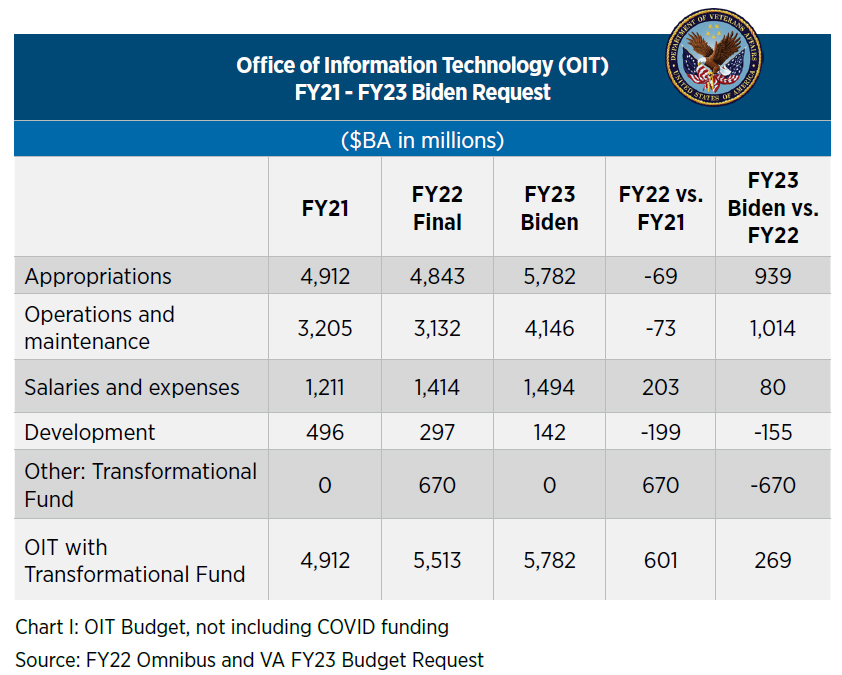

VA continues its stunning pace of growth, both on the discretionary and mandatory sides of the federal budget. If the President’s total FY23 VA Budget request of $301.4 billion is enacted, VA budget documents show VA funding (discretionary and mandatory) will have grown 37% since FY20 and an astounding 116% since FY13 (nominal). Before diving into the $139 billion discretionary side of the VA budget request—medical services, equipment, information technology, research, administration—it is important to note that the mandatory part of VA’s budget—veterans’ compensation, pensions and education benefits—represents $161 billion, 53% of VA’s planned FY23 operating budget.
As noted earlier, FY23 budget documents do not compare FY23 funding requests to final FY22 numbers for any agencies. VA’s FY23 budget was sent to Congress 13 days after FY22 funding levels were finalized in the omnibus appropriations law, making real year-to-year comparisons impractical. Because FBIQ is focused on untangling that, our analysis will differ from budget press releases.
VA is the fastest growing department in the federal government. That growth is fueled by patient care growth, technology, and infrastructure needs. Biden’s FY23 request for VA’s discretionary budget is $139.1 billion, a $22.7 billion (+19%) increase above 2022 (budget numbers include collections VA makes from veterans with private insurance). VA staffing follows these growth patterns, with a projection of 435,900 Full Time Equivalents (FTEs) for FY23, an increase of about 10,000 over FY22 projections, and 33,500 over the FY21 level of 402,400 FTEs.
This budget shows how deeply this President values veterans, their families, caregivers and survivors…they deserve our very best and with this budget, that’s exactly what we’ll give them.
Secretary McDonough,
April 6 House Appropriations Hearing
COVID Funding Update
Outside the regular budget process, the American Rescue Plan Act (ARP), signed into law March 11, 2021, provided VA with $17.1 billion in funding for VA’s COVID-19 response and related veteran needs, including medical requirements, addressing claim backlogs, and unemployment training. VA plans to obligate $12 billion (70%) of those funds in FY22 and $4.3 billion in FY23. The bulk will go to Medical Services and Medical Community Care, but Medical Facilities (which includes IT infrastructure for those facilities) will receive $2.2 billion in FY22 and $392 million in FY23, and the Office of Information Technology will receive $635 million in FY22 and $630 million in FY23.
VA’s FY23 budget request highlights include:
- $13.9 billion for mental healthcare, focusing on access to care and lowering veterans’ costs, including $497 million specifically for suicide prevention
- $2.7 billion to eliminate veteran homelessness
- $4.8 billion on telehealth treatment and $329 for the Office of Connected Care
- $5.8 billion for the Office of Information and Technology
- $1.8 billion for the Electronic Health Record Modernization (EHRM) project
- $916 million for research, including scientific computing, researcher “cloud credits” and use of AI
- $3.9 billion for Veterans Benefits Administration, focused on accurate and faster claims processing. This includes $120 million to automate the disability compensation claims process from submission to authorization
OIT Budget – FY22 Final and FY23 Biden Budget
Final FY22 funding for OIT is $5.5 billion, $600 million more than the FY21 level and the same as Biden’s FY22 budget. Total funding includes $4.8 billion in a standard appropriation and $670 million from VA’s Transformational Fund. For FY23, the Biden request is $5.8 billion, a $269 million increase over FY22. No funding from the Transformational Fund is included in the OIT FY23 request. COVID funding is not included in these amounts. Earlier, we noted that VA plans to obligate more than $1 billion of ARP funds to OIT: $635 million in FY22 and $630 million in FY23.
The OIT budget request is comprised of Operations and Maintenance, Development, and Salaries and Expenses (see Chart I for details). Operations and Maintenance sees a $1 billion-plus increase, up 32% over FY22. VA continues to cut development funding further, requesting $142 million for FY23 (52% less than the FY22 level) as OIT continues the shift from building customized VA systems in-house to focus on Commercial Off-the-Shelf (COTS) products. Large FY22 OIT staffing increases (+500 FTE) are sustained in FY23.


FY23 OIT priorities include:
- Support VA’s “astronomical growth” in telehealth services. The FY23 request includes $31.5 million in OIT for Telehealth Services, including $13.7 million in Development, $9.1 million in O&M, and $8.7 million in COVID funding from ARP. Veteran care through telehealth is increasing 30 percent per year, currently serving 909,000 veterans. By 2026, VA projects nearly all veterans will have access to telehealth services
- $770 million for IT infrastructure, including hardware and software maintenance and IT support contracts, including the transition to VA’s Enterprise Cloud Solution (VAEC)
- $478 million for the Infrastructure Readiness Program, including $150 million for desktops, $135 million for networks, and $115 million for server/storage farms
- $457 million for Cybersecurity, Privacy and Records Management
- Support the two large corporate systems – $123 million for the Financial Management Business Transformation and $64 million for Human Resources Information Service
- $96.5 million for supply chain activities, which does not include funding for the Defense Medical Logistics Standard Support (DMLSS)
- $141 million to support VHA Community Care projects, including automation for pharmacies
- $81 million for Veterans Benefits Management to improve and modernize claims processing
Supply Chain Reassessment
The FY23 budget request for VA’s varied supply chain activities is $96.5 million, which includes $33 million in Development for Enterprise Supply Chain (eSC) and $63 million in O&M for supply chain services and a graphical user interface. The most significant change is that the Biden budget includes no funding for the Defense Medical Logistics Standard Support (DMLSS), which had been VA’s 10-year $1 billion designated supply chain solution.
DMLSS is being reassessed as VA conducts an enterprise-wide “Supply Chain Strategy Assessment” under direction of the VA Deputy Secretary. The American Rescue Plan, included $100 million for VA’s medical supply chain, but Congress rescinded $76.1 million of those funds in the FY22 Omnibus without comment. With legal challenges relating to the procurement upheld by the Court of Federal Claims, VA has stated that “currently, VA is developing a plan to reopen a competition for developing the enterprise supply chain/medical logistic solution.” There is no VA timeline for this procurement.
As that plan is being developed, requested FY23 VA supply chain activities focus on “system agnostic activities which directly support Supply Chain Modernization” including logistics environment development, technical analysis to address gaps in the VA Supply Chain Business processes, and enterprise data management.
Electronic Health Records Modernization (EHRM) “Strategic Revision”
The final FY22 budget for EHRM was $2.5 billion, $167 million below the Biden FY22 request. In addition, Congress rescinded $200 million in prior-year EHRM funding. Although VA budget documents do not reflect these cuts, we expect them to impact the FY23 EHRM spending plan. The Biden FY23 budget requests $1.8 billion for EHRM, noting that lessons learned from previous deployments will change budgetary requirements and deployment schedules. VA’s FY23 EHRM request “reflects a strategic revision to the original EHRM deployment schedule, determining a way forward after the initial phase through early 2024.”
The $1.8 billion FY23 request supports 16 deployments, a reduction from the 25 planned for 2022, and $440.7 million for Infrastructure Readiness for updated computers and network infrastructure at deployment sites.
In addition to the EHRM program request, VA includes $505 million in the Medical Facilities account within the Veterans Health Administration budget for IT infrastructure projects required to support EHRM deployments. This partially responds to criticism by the VA Inspector General about inadequate preparation, assessment, and management of local IT infrastructure costs needed to support EHRM.
FY23 Outlook
Given VA’s strong bipartisan political support, we expect VA’s FY23 budget request to be received favorably, although there will be a lot of questions about EHRM progress and the supply chain initiative pause. House appropriations subcommittee markups are scheduled to start June 13 and several full committee markups could be complete before July. Commonly, the VA spending bill (which also includes military construction) is one of the first bills considered by the House. VA’s topline should be sustained, but as the majority of VA’s COVID funds are exhausted in FY23, VA could face challenges as patients return to catch up on COVID-deferred health appointments. Overall, the VA information technology budget doesn’t provide a lot of targets for cuts and, given the mission-critical importance of IT in delivering services to veterans, OIT and other IT infrastructure investments are likely to maintain robust funding levels.